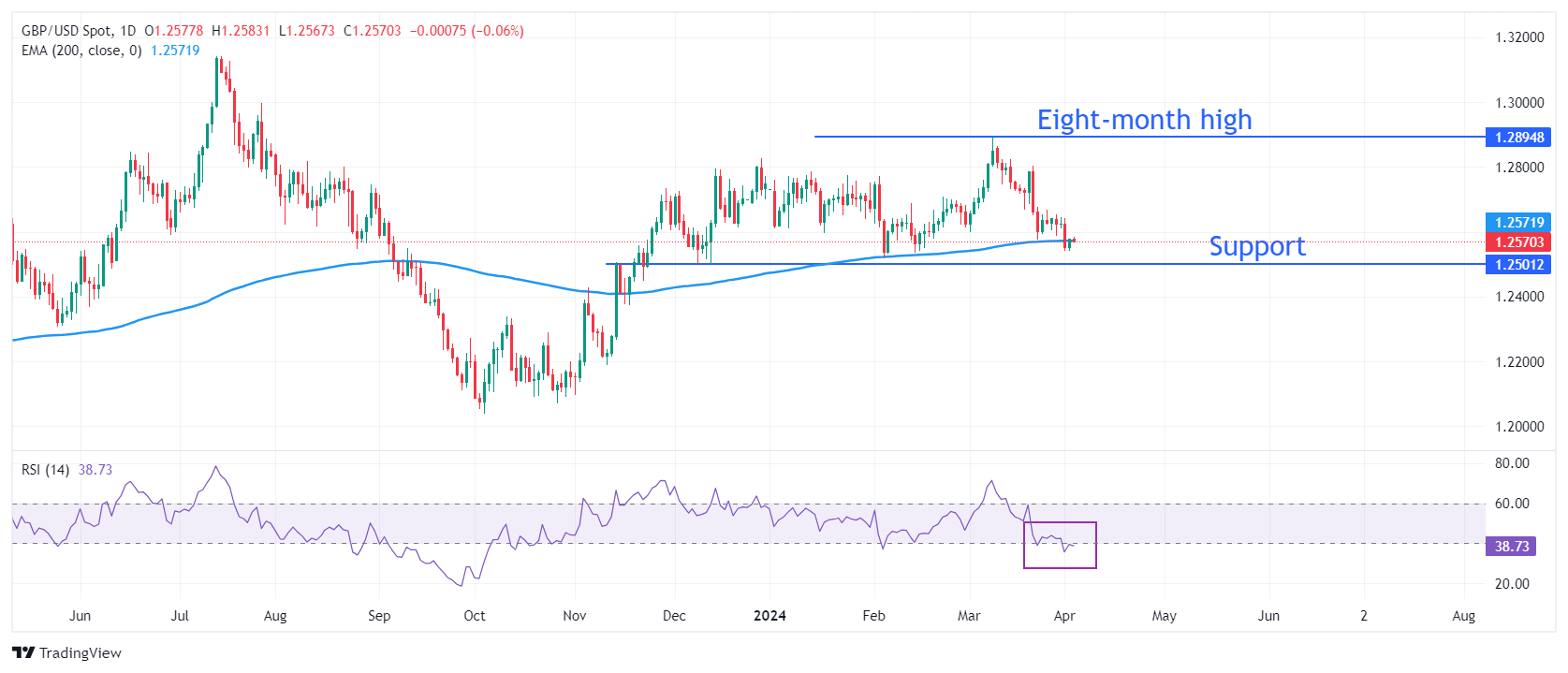- The British Pound takes advantage of the risk-on sentiment and rises to 1.2660.
- Upbeat UK manufacturing PMI data and rising house prices suggest the H2 2023 recession was shallow.
- The US NFP data will guide the next move of the US Dollar.
The British Pound (GBP) aims to extend its recovery above the one-week high of 1.2660 in the early Thursday session in New York. The GBP/USD pair is exhibiting strength as recent UK economic indicators have shown the economy is on track to return to growth after falling into a technical recession in the second half of 2023. Meanwhile, a weaker US dollar due Poor services PMI data from the US Institute for Supply Management (ISM) for March also boosted the Pound.
The UK manufacturing PMI rose surprisingly in March after 20 consecutive months of contraction, driven by strong domestic demand. Strong British factory data boosted business optimism to its highest level since April 2023, with 58% of manufacturers expecting their production level to increase in the next 12 months. Additionally, British house prices rose 1.6% in March, the highest pace since December 2022, suggesting the property sector is holding up despite historically higher interest rates.
In the European session, the latest survey from the Bank of England's (BoE) Decision Makers Panel (DMP) for February showed that most companies see a cooling in selling prices and wage inflation during the next year. Selling price expectations slowed to 4.1% from 4.3%, the lowest reading in more than two years. Wage growth expectations softened to 4.9% on a three-month moving average, from 5.2% in February.
Daily market developments summary: Sterling extends its winning streak
- The British Pound moves sideways after advancing to 1.2660 against the US Dollar. The asset is expected to extend the bullish streak as market sentiment is bullish and weakness in the US ISM Services PMI has pushed down the US Dollar. S&P 500 futures have posted significant gains in the Asian session.
- On Wednesday, the US services PMI surprisingly fell to 51.4 in March, compared to expectations of 52.7 and the previous reading of 52.6. The services PMI measures business activity in the services sector, which accounts for two-thirds of the U.S. economy. Therefore, the impact of a bad Services PMI was significantly adverse for the US Dollar, dragging the US Dollar Index (DXY) down more than 0.5% to 104.15. The ISM report also showed that the sub-indices for new orders and prices paid fell significantly.
- This week, the main driver of the US Dollar will be the March Non-Farm Payrolls (NFP) report, due out on Friday. The economic data will have a significant impact on market expectations about whether the Federal Reserve will begin reducing interest rates starting with the June meeting. The NFP report is expected to show that 200,000 workers were hired during the month, down from February's reading of 275,000.
- As for the UK, the Pound will be guided by market expectations of the Bank of England's rate cut. Investors expect the BoE to start the rate cut cycle in June as UK inflation is steadily slowing. For the year as a whole, BoE Governor Andrew Bailey said he sees expectations of two or three rate cuts as “reasonable.”
- Meanwhile, S&P Global/CIPS has reported that the services PMI missed expectations in March. The services PMI falls to 53.1, compared to expectations and the previous reading of 53.4. Tim Moore, Chief Economics Officer at S&P Global Market Intelligence, said: “The service sector output recovery lost a bit of momentum during March, and more than the preliminary PMI results suggest, but the overall picture remains reasonably positive.”
Technical Analysis: Sterling refreshes weekly highs near 1.2660

Sterling rebounds to one-week highs near 1.2660 after discovering buying interest from six-week lows at 1.2540. The GBP/USD pair continues its winning streak for the third consecutive session. Pound bulls respected the 200-day EMA at 1.2566. The 20-day EMA near 1.2660 could act as a strong barrier going forward.
On a longer time frame, horizontal support from the December 8 low at 1.2500 would provide further cushion to the British pound. Meanwhile, rallies are expected to remain limited near an eight-month high around 1.2900.
The 14-period Relative Strength Index (RSI) bounces above 40.00 after falling below. It should not be considered a “bullish reversal” until it breaks decisively above 60.00.
Frequently asked questions about Gold
Why invest in Gold?
Gold has played a fundamental role in human history, as it has been widely used as a store of value and medium of exchange. Today, aside from its brilliance and use for jewelry, the precious metal is considered a safe-haven asset, meaning it is considered a good investment in turbulent times. Gold is also considered a hedge against inflation and currency depreciation, since it does not depend on any specific issuer or government.
Who buys more Gold?
Central banks are the largest holders of Gold. In their aim to support their currencies in turbulent times, central banks tend to diversify their reserves and purchase Gold to improve the perception of strength of the economy and currency. High Gold reserves can be a source of confidence for the solvency of a country. Central banks added 1,136 tons of gold worth about $70 billion to their reserves in 2022, according to data from the World Gold Council. This is the largest annual purchase since records exist. Central banks in emerging economies such as China, India and Türkiye are rapidly increasing their gold reserves.
What correlation does Gold have with other assets?
Gold has an inverse correlation with the US Dollar and US Treasuries, which are the main reserve and safe haven assets. When the Dollar depreciates, the price of Gold tends to rise, allowing investors and central banks to diversify their assets in turbulent times. Gold is also inversely correlated with risk assets. A rally in the stock market tends to weaken the price of Gold, while sell-offs in riskier markets tend to favor the precious metal.
What does the price of Gold depend on?
The price of Gold can move due to a wide range of factors. Geopolitical instability or fear of a deep recession can cause the price of Gold to rise rapidly due to its status as a safe haven asset. As a non-yielding asset, the price of Gold tends to rise when interest rates fall, while rising money prices tend to weigh down the yellow metal. Still, most of the moves depend on how the US Dollar (USD) performs, as the asset is traded in dollars (XAU/USD). A strong Dollar tends to keep the price of Gold in check, while a weaker Dollar is likely to push up Gold prices.
Source: Fx Street
I am Joshua Winder, a senior-level journalist and editor at World Stock Market. I specialize in covering news related to the stock market and economic trends. With more than 8 years of experience in this field, I have become an expert in financial reporting.







